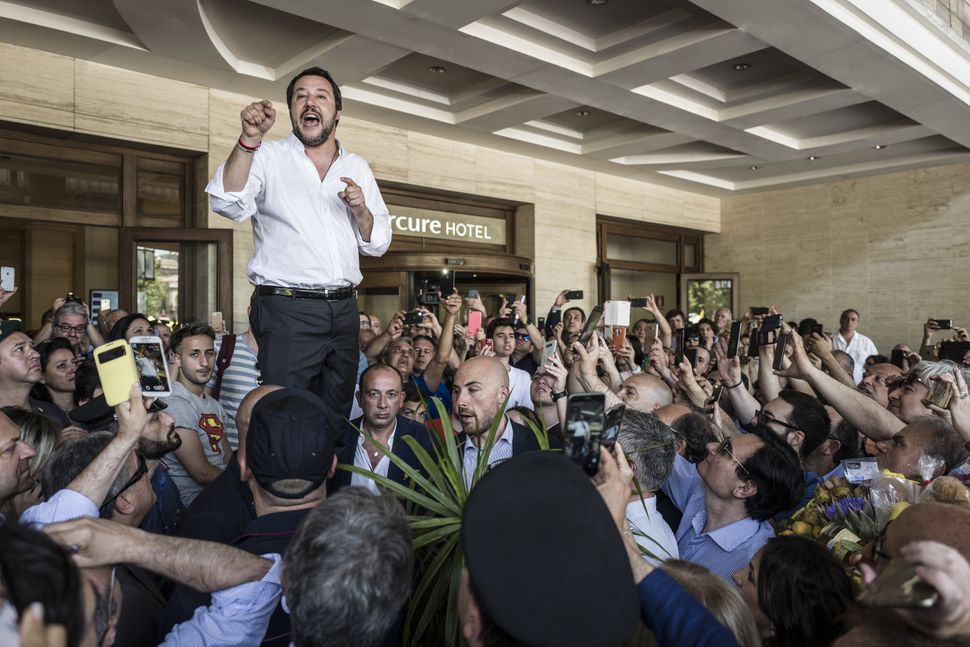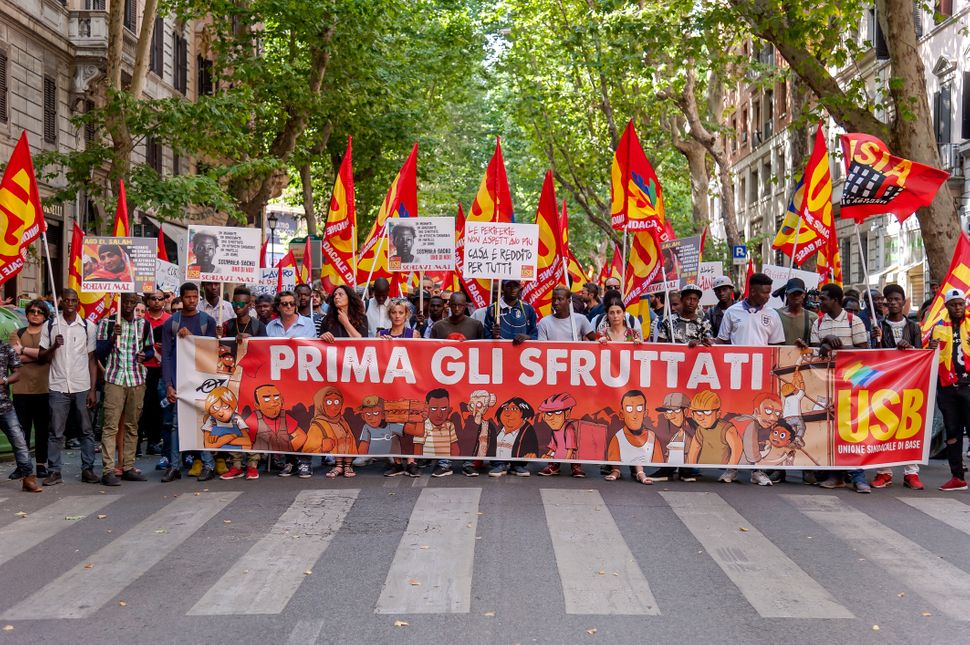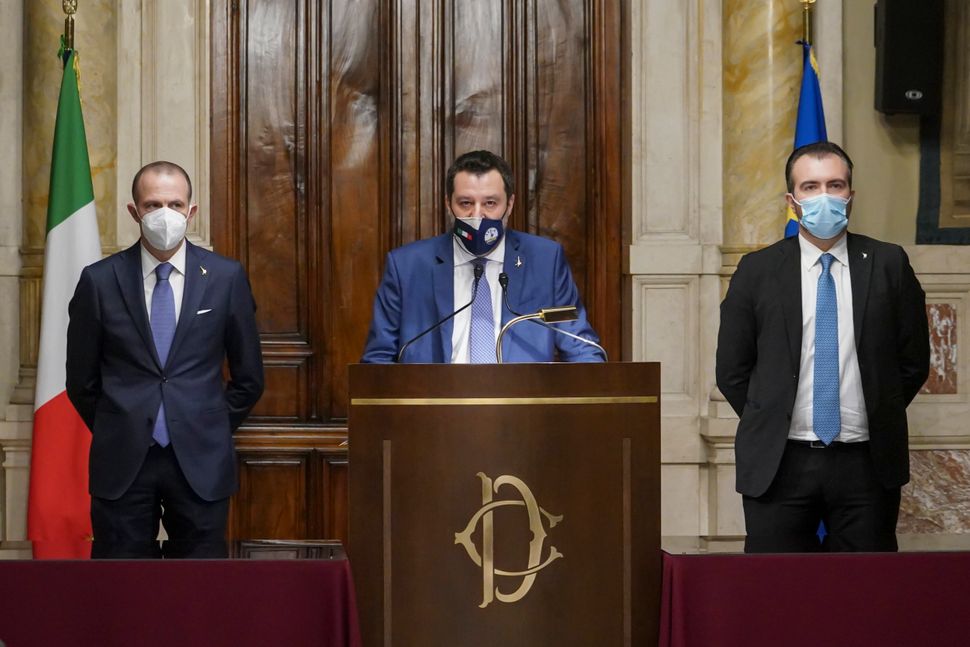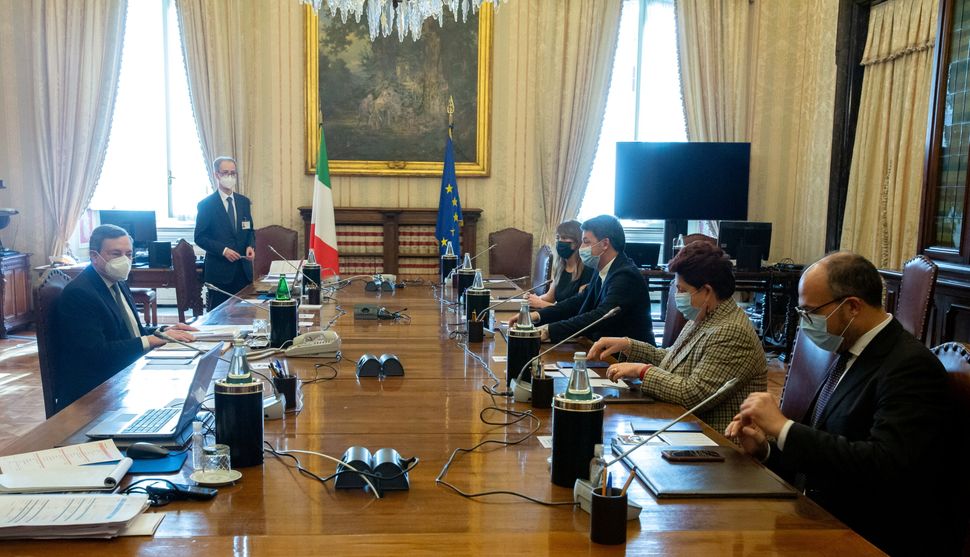
LONDON — It took 88 days of negotiations and one of the most contentious elections in Italy’s history, but on May 31, 2018, the country emerged with a radical far-right government that sent shockwaves across the globe and put it on a collision course with the rest of Europe.
Threatening to deport 500,000 migrants, exit Europe’s single currency and bring Italy closer to Russia, the populist government was seen as the worst possible outcome for the European Union, leading to fears it marked the beginning of the end for the then 28-country bloc.
“Open doors in Italy for good people and a one-way ticket for those who come to Italy to create commotion and think they will be taken care of,” Deputy Prime Minister Matteo Salvini said within hours of taking office. “Send them home will be one of our top priorities.”
If his point wasn’t clear enough, Salvini, who had previously blamed migrants for bringing crime and disease to Italy, tweeted a video depicting an immigrant plucking a pigeon. “Go Home!!!” he wrote.

Now, almost three years since Salvini’s League-Five Star coalition took power, Europe is fighting another crisis and Italy is forming yet another government, its 68th since WWII. This time, however, both the mood of the Italian people, and the position of Salvini, have shifted dramatically.
“On the issue of immigration, we will propose the adoption of European legislation,” Salvini said this week, a far cry from his angry calls for “closed ports and zero landings.” “It is good for us that immigration in Italy is treated as it is treated in France and Germany, with the same rules.”
But it’s Salvini’s backing of Mario Draghi, Italy’s prime minister-designate and the man charged with spending more than 200 billion euros ($240 billion) in EU funds to help relaunch the country’s pandemic-ravaged economy, that is most striking.
Not only had Salvini campaigned for Italy to quit the European single currency, which Draghi is credited as saving while European Central Bank chief, the League Party leader had accused him of being an “accomplice” in what he termed the economic “massacre” of Italy.

“The League wants to join Draghi in order to clear its name in Europe, to get rid of its reputation as a eurosceptic party,” a senior League source told Reuters.
Draghi is likely to present his list of ministers on Friday and unveil his policy program next week in Parliament.
Most feared man in Europe
The once unthinkable coalition deal between the far-right League and anti-establishment Five Star parties, which helped elevate Salvini from regional council member to an international strongman, had actually been brewing for years.
Anger over EU-backed austerity measures imposed after the 2008 financial crisis and fears over immigration led Italians to reject the country’s once-powerful establishment parties. Promising the poor a guaranteed income, pension reform and the rebuff of migrant boats, the League-Five Star coalition filled the void.
Dubbed the “most feared man in Europe,” Salvini soon became one of the most powerful and divisive politicians in the world, courting fellow populist leaders including Donald Trump and Brazil’s Jair Bolsonaro.
Closer to home, Europe was gripped in a wave of populism as elections across the continent in 2018 confirmed the surging popularity of far-right leaders, who after decades on the fringes were forming governments by themselves or in coalitions.
After transforming the League from a troubled regional party into Italy’s most popular, which won 34% of the vote in European Parliament elections in 2019, Salvini quit the government, hoping it would trigger an election and install him as prime minister.
It proved to be an awful miscalculation. The center-left Democratic Party unexpectedly replaced the League in government and dumped Salvini into the opposition, where his approval ratings plummeted.
Watershed moment
In an ironic twist, Salvini’s 2021 political resurrection has not only changed Italy’s political landscape, but has split the continent’s eurosceptic and populist parties, including the likes of Marine Le Pen’s National Rally in France and Germany’s Alternative for Deutschland.
“Salvini’s conversion is a watershed in Italy and Europe,” HuffPost Italy editor-in-chief Gianni Del Vecchio said. “This completes the work of normalizing populist parties: Italy’s Five Star Party became a pro-European and Atlanticist party in 2019. Now it’s the League’s turn.”
The League’s far-right allies in the European Parliament are furious at the prospect of Salvini backing a government led by Draghi, who is expected to immediately set to work on an economic recovery plan, hoping to utilize the billions in EU funds on offer.

“It is a joke, but a very bad one that the Germans … will not be able to laugh at,” said Joerg Meuthen, co-leader of the far-right Alternative for Deutschland, arguing that Berlin will end up footing much of the bill.
In response, League politicians have upped the stakes, reviving speculation that Salvini might soon abandon the European Parliament’s far-right faction and join the main center-right parties.
League politicians say it is a calculated move, aimed at improving Salvini’s image, thereby enhancing his prospects of one day becoming prime minister, while boosting the appeal of their group, whose poll ratings have been in decline.
“We want to become like the Republican Party in the United States. An inclusive party that reconciles all the positions of the Italian center-right, no one excluded,” Giulio Centemero, a League parliamentarian, told Reuters.
The League has seen an immediate bump in its poll ratings, thanks to its decision to join the new, broad-based government, with support climbing 0.7 points over the past week to 24% ― the biggest increase of any party, according to pollsters.
Salvini’s “move shows the League is a fully mature party and makes it clear that it is a trustworthy party of government,” said Gianluca Cantalamessa, one of the League’s new wave of lawmakers from southern Italy.
In the room where it happens
Salvini 2.0 may not display the same firebrand nature, but his political instincts are no less sharp, and his conversion from populist poster boy to pro-European cheerleader comes at one of the most critical moments in modern European history.
At stake is 200 billion euros ($243 billion) from the EU, part of a $910 billion rescue fund designed to revitalize Italy’s battered economy, which even before COVID-19 plunged the country into its steepest post-war recession had barely grown for two decades.

Regional governors within Salvini’s party had urged their leader to back Draghi’s promotion in order to guarantee a share of the spoils, confident he would draw up business-friendly plans to spend the EU’s money. There was “little opposition” to the policy shift, according to party insiders.
“The pandemic has shown that polarizing policies are not accepted by citizens in the face of suffering. Voters want solutions for their problems,” said Nicola Pasini, a political science professor at Milan University.
While the pandemic has caused Italy’s latest political earthquake, Del Vecchio said the tremors could be felt across Europe.
“Currently populism is in a minority in Italy,” Del Vecchio said. “In Europe, the same thing could happen. The EU’s populist group split into three in the last vote of the European Parliament on the recovery plan. The Italian case could therefore be the first sign of a crisis among European sovereigntists.”
But in a country where governments have had an average lifespan of a little over a year since WWII, Roberto D’Alimonte, a politics professor at Rome’s Luiss University, predicts Salvini won’t hesitate to change tack if the Draghi experiment fails.
“This is a strategic choice that will be consolidated only if things go well. If things go badly, then it is all over. He will return to the nationalist camp,” D’Alimonte said.
HuffPost Italy and Reuters contributed reporting.
Calling all HuffPost superfans!
Sign up for membership to become a founding member and help shape HuffPost’s next chapter
Related posts:
Views: 0
 RSS Feed
RSS Feed

















 February 13th, 2021
February 13th, 2021  Awake Goy
Awake Goy  Posted in
Posted in  Tags:
Tags: 
















